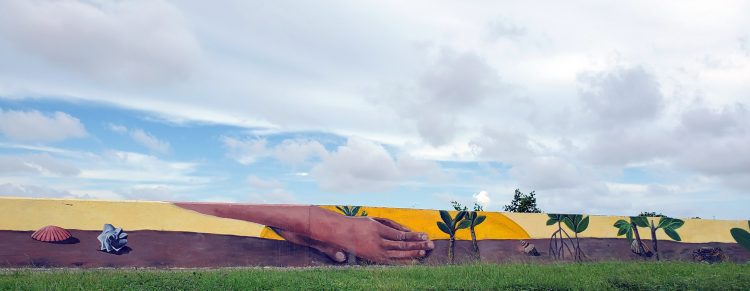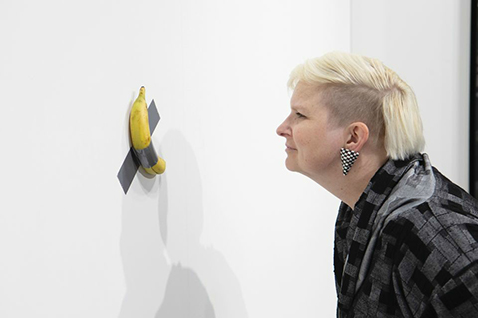By Akima McPherson
As I waited along the eastbound carriageway at the junction of UG Road and Rupert Craig Highway for the lights to turn green, I turned my head to the left and glimpsed a slither of tranquility and serenity beyond the vehicle which partially obscured my view. Before me was a skillfully and beautifully painted snippet of a mural – feet walking across brown sand away from the hustle and bustle of the junction. My mind wandered. I imagined carefree individuals walking towards, then along the edge of the ocean and their bare feet slightly sinking into the moist brown sand. I thought of the small boats with paint peeling that may be moored along the beach and of the travels they accumulated as they were rocked by the ocean’s waves. And I thought of lovers walking hand-in-hand. In the passage of a minutia of time, my mind had traveled in time and space because of the implications of an unexpected encounter with art.
Everything is not art; I am not that person who would say otherwise. Art, in my humble practitioner opinion, should engage one’s aesthetic sensibility (one’s sense of beauty) as well as one’s intellect. It is not an either-or for me. The two must be present. Of course, aesthetics are variable – obscured in individual sensitivity, mediated by cultural norms, and inconstant. I accept this. Thus, what I find beautiful may not be to the other person, but for an object to gain status as art in my opinion it must engage the intellect always. Otherwise, it is craft – skillful manipulation of materials to make an object which may or may not be utilitarian. Therefore, craft is defined by skill and utility. Additionally, the craft object exists for its beauty, variable and relative as this may be. An object, on the other hand, gains status as art the more it moves along the continuum away from craft. Mind you, the art object emerges out of skill also. Nonetheless, the less utilitarian the object becomes and the more it relies on intelligence and intellect to be appreciated and understood, the more in the realm of art the object exists.
That being said, not every object that gains status as art is good art. Oftentimes, when we ask ourselves, “but is this art?” or “how is this art?” we are really asking ourselves “is this good art?” or “how is this good art?” The assumption can be that a thing has merit hence it is art; it is art, therefore, it must have merit – it must be good. As a result, we often say “that is not art” when we mean to say “that is not good art”.
The layperson does not get to assign art status to objects. That assignment of status is the duty of the art institutions – the artists, critics, and art establishments like galleries and museums. And these arbiters of art do not have to have a consensus. Thank Heavens! Our responsibility as an audience (lay or informed) is really to decide whether we accept the institutional assignment of art status and if we do, is it good art or bad art? Why is it art (or not)? Why is it good art (or not)? What is the work of art saying? Do we agree with the propositions being made? Etc. Art, therefore, really needs to be perceived as a language and a vehicle of communication.
Furthermore, just as we are receptive to disagreement when we hear the spoken word, so too with art we can disagree with what we are being told through the visual. However, the notion that the artist is a genius with special attunement to life and nature is not one I subscribe to. Not at all. I think if the artist evidences an extraordinary attunement it is because he or she cultivated it in pursuit of art. Hopefully, as art-making skill was cultivated, he or she cultivated the mind to have something worthy to say to the world that encounters his or her work.

In December 2019, the global art world was all a buzz with excitement for some and confusion for others. At Art Basel Miami (a premier exhibition for artists and gallerists), Italian artist Maurizio Cattelan duct-taped to a wall a yellow-skinned banana. The tape and fruit formed an obvious ‘X’. Catellan’s gallerist Frenchman Emmanuel Perrotin sold the work for US$120,000. For some, the work was absurd, a joke, a bit of visual anarchy, but for others it was a brilliant visualisation of the state of art. Not that the state of art is all bananas – although perhaps there is enough evidence to support this – but because the definition of art simply does not exist and so the parameters of what is a work of art, in a community of vibrant art dialogue is constantly undergoing reconceptualisation and redefining.
Although an art conservator’s nightmare, in a world where the idea is as much the art as the actual objects made or appropriated, Cattelan’s banana is art. It insists that we continue to think about the definition of art. Additionally, its achievement of the accolade of good art or excellent art, in part relies on how the elements of art and the principles of design come together. In this series of articles that I am now inaugurating, I will introduce and explore these fundamental building blocks of art, and relate each of them to works done by young, lesser-known Guyanese artists. Each is a graduate of the University of Guyana’s Division of Creative Art (UG DCA) and many also preceded their studies at the UG DCA with Diploma Studies at the E.R. Burrowes School of Art. Hopefully, at the end of this series of articles, your relationship with art will be enriched and you may have discovered some gems you will look out for in the future.
Art is not nonsense. Art is the most fundamental of things to define living over existing. I have no one to quote on that, just my own life experience to guide me. Art, while it is hard to define, and I will not even bother to offer an inadequate definition, speaks for me when I cannot. Therefore, I hope that as you journey with me you too will find in art a comforter for gloomy days, a celebrant for the joy-filled ones, and a companion for those in between.
Akima McPherson is a multi-media artist, art historian, and educator.





